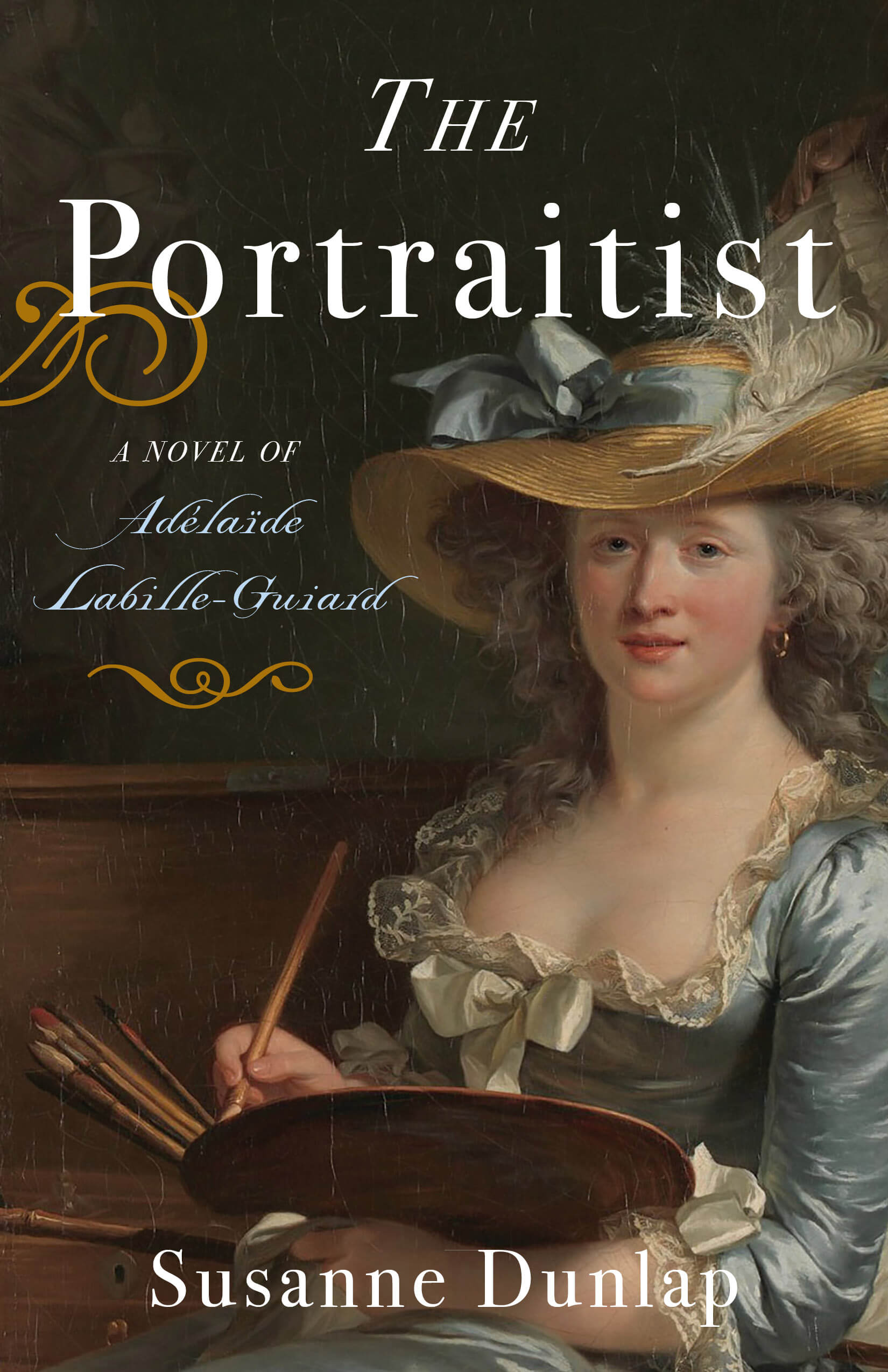 CIBA Award-winning author uses true events to create inspiring and hopeful tale
CIBA Award-winning author uses true events to create inspiring and hopeful tale
BIDDEFORD, Maine – Adélaïde Labille-Guiard is ready to draw the line between art and politics in The Portraitist: A Novel of Adélaïde Labille-Guiard (Aug 30, 2022, She Writes Press). Award-winning author Susanne Dunlap paints a historical retelling of real-life Adélaïe Labille-Guiard, a female portraitist and painter, and her earnest battle to win recognition as an artist in 18th century Paris amidst the French Revolution.
Paris, 1774. After her separation from her abusive husband, Adélaïde Labille-Guiard is at last free to pursue her dream of becoming the premier woman portraitist in Paris. Free, that is, until she discovers at her first public exhibition that another woman artist is poised to claim that role — and she has more training and better connections in the tightly controlled art world.
To have a chance of competing, Adélaïde must first improve her skills in oil painting. But her love affair with her young teacher gives rise to suspicions that he touches up her work, and her decision to make much-needed money by executing erotic pastels threatens to create as many problems as it solves.
As her rival gains lucrative portrait commissions and an appointment as portraitist to Queen Marie Antoinette, Adélaïde continues to struggle, until at last she earns a royal appointment of her own, and, in 1789, receives a massive commission from a member of the royal family.
But the timing couldn’t be worse. Adélaïde’s world is turned upside down by political chaos and revolution. With danger around every corner of her beloved Paris, she must find a way to survive and adjust to the new order, starting all over again to carve out a life and a career—and stay alive in the process.
The Portraitist is based on the true story of one woman artist’s fight to take her rightful place in a man’s world — and the decisions she makes that lead her ultimately to the kind of fulfillment she never expected.
“The Portraitist”
Susanne Dunlap | August 30, 2022
She Writes Press | Historical Fiction
Paperback | 978-1647420970 | $17.95
Ebook | B09NNDP8KG | $9.95
More about Susanne Dunlap
 Susanne is the author of twelve works of historical fiction for adults and teens, as well as an Author Accelerator Certified Book Coach. Her love of historical fiction arose partly from her studies in music history at Yale University (PhD, 1999), partly from her lifelong interest in women in the arts as a pianist and non-profit performing arts executive. Her novel The Paris Affair won first place in its category in the CIBA Dante Rossetti awards for Young Adult Fiction. The Musician’s Daughter was a Junior Library Guild Selection and a Bank Street Children’s Book of the Year, and was nominated for the Utah Book Award and the Missouri Gateway Reader’s Prize. In the Shadow of the Lamp was an Eliot Rosewater Indiana High School Book Award nominee. Susanne earned her BA and an MA (musicology) from Smith College, and lives in Biddeford, ME, with her little dog Betty. You can find her at https://susanne-dunlap.com
Susanne is the author of twelve works of historical fiction for adults and teens, as well as an Author Accelerator Certified Book Coach. Her love of historical fiction arose partly from her studies in music history at Yale University (PhD, 1999), partly from her lifelong interest in women in the arts as a pianist and non-profit performing arts executive. Her novel The Paris Affair won first place in its category in the CIBA Dante Rossetti awards for Young Adult Fiction. The Musician’s Daughter was a Junior Library Guild Selection and a Bank Street Children’s Book of the Year, and was nominated for the Utah Book Award and the Missouri Gateway Reader’s Prize. In the Shadow of the Lamp was an Eliot Rosewater Indiana High School Book Award nominee. Susanne earned her BA and an MA (musicology) from Smith College, and lives in Biddeford, ME, with her little dog Betty. You can find her at https://susanne-dunlap.com
Follow Susanne on social media:
Facebook: @SusanneDunlapAuthor
Twitter: @susanne_dunlap
Instagram: @susanne_dunlap
LinkedIn: @susannedunlap
Pinterest: @susanne_dunlap
Advance Praise for ‘The Portraitist’
“An imaginative work that brings the story of a little-known artist to vivid life.”
– Kirkus Reviews
“Deeply researched and imagined, The Portraitist offers a fascinating and dramatic plunge into the world of a brilliant female artist, struggling to make her mark before and during the turbulent and treacherous era of the French Revolution. I loved this novel.”
– Sandra Gulland, internationally best-selling author of The Josephine Trilogy
“Written with breathless drama, The Portraitist follows the rise of the gifted portraitist Adélaïde Labille-Guiard in Paris during the last years of the late eighteenth century. The novel is a luminous depiction of Paris and those terrible times seen through the astute, compassionate eyes of a woman who had to paint. Every bit of lace, or royal carriage or bloody cobblestone is alive in the writing. The rain drumming on the skylight and a misbuttoned coat speak. Go to those streets with this book in your hand to follow her footsteps and those long-gone turbulent times will come alive to you as if they were yesterday.”
– Stephanie Cowell, award-winning author of Claude and Camille
“In The Portraitist, Susanne Dunlap skillfully paints a portrait of a woman struggling to make her way in a man’s world– a topic as relevant today as it was in Ancien Regime France. Impeccably researched, rich with period detail, Dunlap brings to life the little known true story of Adélaïde Labille-Guiard, who fought her husband and society to make a name for herself as a painter to the royal family, the very apex of success– only to find everything she had built threatened by the Revolution. A stunning story of determination, talent, and reversals of fortune. As a lifelong Elisabeth Vigée-LeBrun fan, I am now questioning my allegiances!”
– Lauren Willig, New York Times bestselling author of The Summer Country and Band of Sisters
“[The Portraitist is a] luminous novel of Adélaïde Labille-Guiard, whose livelihood and longing for respect are threatened by the institutions that deny women artists their due, compounded by the tumultuous events of the French Revolution. Deftly written and impeccably researched. Highly recommended.”
– Michelle Cameron, award-winning author of Beyond the Ghetto Gates
In an interview, Susanne Dunlap can discuss:
- 18th century art and music and its inspiration in the story
- Researching Adélaïde Labille-Guiard and the true stories within the book
- The feminist themes and struggles of women in 18th century Paris
- How the French Revolution affected art and music during this time
- Her PhD in music history and particular interest in women in the arts helped shape her storytelling and the importance of the female narrative
- Her previous works (Orphans of Tolosa Trilogy, The Musician’s Daughter, Theresa Schurman Mysteries)
- Her work as a book coach and how it extends to her own creative process
An Interview with Susanne Dunlap
What inspired you to write about Adélaïde Labille-Guiard?
I’ve always been interested in women in the arts, and the eighteenth century has a special place in my heart (my dissertation was about eighteenth-century opera). Also, Adélaïde’s self-portrait with her two students that hangs in the Metropolitan Museum of Art in NY is a huge favorite of mine. But originally, when I first conceived of the book, I thought of her in relation to her rival, Vigée Le Brun. Through research I began to know her in her own right, and to appreciate how different her life must have been from her rival’s, how much more stood in her way. I also love the difference in her painting style from Le Brun’s. It feels much more real, more present, less beautiful in a good way.
Why focus on Adélaïde instead of Élisabeth Vigée Le Brun?
Originally I thought I would write about Vigée Le Brun. But I love an underdog, and after discovering that they literally followed each other’s footsteps—but Le Brun doesn’t even mention her rival’s name in her three-volume memoir—I was intrigued.
Of course art plays an important role in this book. Are you an artist as well as a musician and writer?
Alas, I am no artist! I took a drawing class in college, but… no. I love art and have always gone to museums, and have done a lot of reading about art history and artists. As research for this book, I did read an 18th-century treatise on oil painting. However, as André Vincent says to Adélaïde before he starts to teach her, there’s a great deal of difference between reading a treatise and actually making art.
While the story is based on a true story, there are some characters that you’ve created. Which of the characters are real?
Most of the characters are, in fact, historical. The ones I’ve created are Adélaïde’s first student (the rest of the named students are historical), her father’s lover, and a few very minor, walk-on characters. However, I took major liberties with the characters of her father and her estranged husband to the point where I might as well have invented them, partly because there was very little available information about them. In those cases, the story comes first.
Did Adélaïde really do a portrait of Robespierre and get a huge commission from the Comte de Provence just as the revolution was starting?
Yep. All true. All the paintings mentioned in the book existed at one time or still exist. The two mentioned in this question are among those that were probably destroyed during the Revolution.
Did Adélaïde really sell erotic pastels?
Alas, no. At least, I could find no evidence of such a thing. However, erotic drawings were a lucrative trade in 18th-century Paris, and my cash-strapped heroine could easily have decided to capitalize on her talents in this way.

A former award-winning journalist with national exposure, Marissa now oversees the day-to-day operation of the Books Forward author branding and book marketing firm, along with our indie publishing support sister company Books Fluent.
Born and bred in Louisiana, currently living in New Orleans, she has lived and developed a strong base for our company and authors in Chicago and Nashville. Her journalism work has appeared in USA Today, National Geographic and other major publications. She is now interviewed by media on best practices for book marketing.

